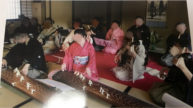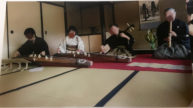For my CIP this semester, I decided to participate in two activities. The first was to volunteer once a week at the iCeMS Science Communications Group, where I worked as a translator and helped with bi-weekly event preparations. The second was working at the Hosokawa Lab of Kyoto University for the Molecular and Cellular Biology Institute for Frontier Medical Sciences. From these two, I got to experience two sides of Japanese work culture: that of the office environment as well as the freer laboratory setting. However, since I spent the majority of my time working in the lab, I will spend this report describing my experiences there and save iCeMS for next semester’s blog post.
Upon coming to Japan, I researched some labs on my own and eventually settled on the Hosokawa Lab, which mainly focuses on the mechanisms of Endoplasmic Reticulum Associated Degradation (ERAD) and the roles of chaperones and lectin function. After sending the first nerve-wracking email to Hosokawa-sensei, I was very ecstatic to hear back from her that I could participate and continue cell biology research in Kyoto despite my one year’s worth of Japanese abilities. We exchanged emails entirely written in extremely formal keigo, which was a challenge to me at the time. Soon enough, I was invited to visit the lab!
My first meeting almost failed to happen – I somehow ended up in the East building (the lab is in the West – thank my poor navigational skills for that), and ended up having to ask two researchers where to go. I was quickly ushered into their office as they dialed the main reception to ask which building I was to head to. From there, a reception worker picked me up from the opposite building and took me directly to Hosokawa’s office. Throughout this process, everyone used keigo and thanked each other politely, and I followed suit, though inside I was already panicking inside. If I can barely use keigo to find my way around the Kyodai campus, how was I going to do that officially – on a daily basis – in a lab?
To my surprise, this worry never came into fruition. First, I was taken aback by just how welcome and cheerful Hosokawa-sensei was from the first time I stepped into her office – she was a character far cry from the more reserved and serious personality I’ve come to expect from older Japanese women. She wore jeans, had unruly hair, and throughout the semester joked about the news, especially regarding the 2016 U.S. election together, with me. She was also the only woman in the lab other than me out of the eight members total, which both 1) stood out to me because I’m used to more women researchers in biology in America, and 2) impressed me because she held the greatest seniority and leadership in what seems to be a male-dominated field in Japan.
As far as other discoveries are concerned, I was mostly amazed at everyone’s utter disregard for keigo whilst in the lab (even the undergrads!). It seemed to me that the norm was apparently to use keigo with others outside of the lab: the deliveryman, and the man who takes orders for lab supplies twice a week, and people you make phone calls to. However, the atmosphere within is much more casual, though still polite (です・ます forms abounded), which made sense to me because the group as a whole seemed very close knit. However, as past students have noticed, this also translated to little socialization with other people of other lab groups, despite it being the opposite case in America.
Throughout the semester, I ended up staying in the lab quite a bit, around twenty hours per week; still, I learned that no matter how hard I work, Japanese PI’s work harder- and for very long periods of time. Usually Hosokawa-sensei leaves long after midnight (“It’s okay because I just live five minutes away!” she proudly exclaims), and comes early the next morning, seven days a week, even on holidays. This of course isn’t to say that all Japanese researchers are workaholics – Tanaka-san, a fellow lab member, apparently likes to take breaks in his day to return to his dormitory, conveniently located two minutes away by bike, to take naps. Furthermore, Hosokawa-sensei herself even took a break one day to take me to see the beautiful autumn leaves in Arashiyama, which goes to show that she isn’t against spending time enjoying herself, but that she truly enjoys doing the work she does.
In addition, there were a couple of other interesting Japanese quirks to the lab that I noticed – taking off your shoes every time you entered a different laboratory, using automatic lights to save energy, and reusing anything and everything that has the potential to be used again. Seeing the dark hallways and crowds of shoes gave me the impression that the facilities in Kyodai were run down at first, but I soon came to appreciate just how much the U.S. can learn from such environmentally-aware habits in the laboratory. Nevertheless, other than these, I felt that doing research in American and Japan didn’t differ as much as one might expect. To this end, I am forever grateful to Hosokawa-sensei, Kyoto University, my labmates, KCJS, and finally, Yale’s Light Fellowship for making this opportunity possible for me. I loved working in the lab, and I hope to continue doing it next semester.


